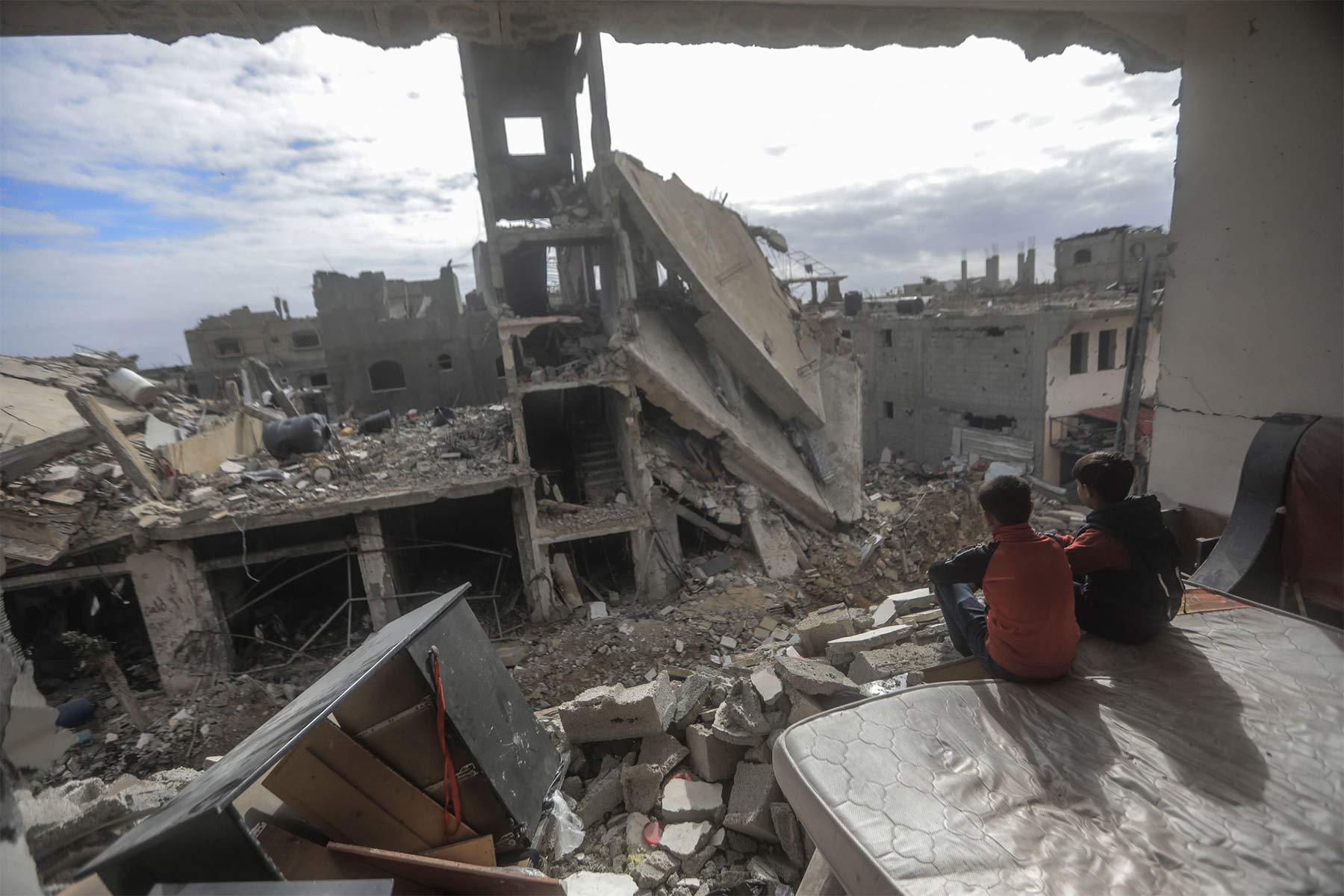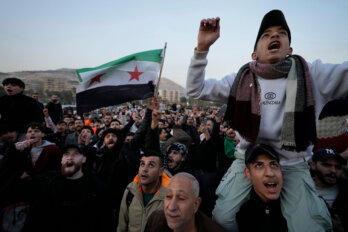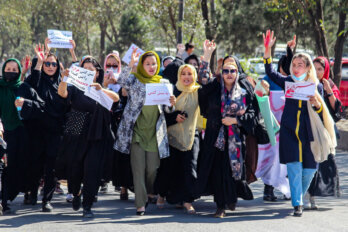When Hamas and Palestinian Islamic Jihad fighters attacked southern Israel on October 7, killing at least 1,200 and taking 240 hostages, many pointed to it as an act of resistance against a settler state and, as such, a form of self-defence. Israeli prime minister Benjamin Netanyahu promised “mighty vengeance,” describing Hamas as an “enemy”; Israel’s allies immediately released statements supporting the nation’s right to defend itself. As of this writing, Israel has killed more than 13,000 Palestinians, nearly half of them children. But if defence is meant to prevent further violence, it’s hard to see how any of this qualifies.
The word “defence” is loaded with emotional and psychological attachments. Defined as the act of protecting someone or something from harm or criticism, it suggests that there is always a clear aggressor and victim. Self-defence is its own justification: if a victim uses violence to protect themselves, they do so only out of necessity.
But “defence” can too easily be moulded into a euphemism for retaliation, revenge, and punishment; in some cases, it provides a gateway to war crimes. The Nazis painted Jews as dangerous when they committed genocide against them. Rwandan political leaders incited massacres of Tutsis under the guise of self-defence. Russian president Vladimir Putin has famously tried to justify Russia’s invasion of Ukraine in 2022 as a defence against Nazism. America’s so-called war on terror following the September 11, 2001, attacks continues to be waged in self-defence, two years after the withdrawal of US troops from Afghanistan. According to a report by Brown University’s Watson Institute, it’s killed more than 4.5 million people, both directly and indirectly, and has arguably bred more hostile militants.
“We know that discourse that conceals the root causes of violence ensures its continuation,” says Muhannad Ayyash, a professor of sociology at Mount Royal University. A ceasefire alone is unlikely to end the Israel–Hamas war. If anyone truly wants to prevent further violence, it’s worth revisiting what defence really means.
In the wake of the Second World War, global leaders sought to prevent future armed conflicts. When the United Nations charter was drafted, in 1945, it prohibited the use of force except when a state is acting in self-defence. Consequently, many government agencies, in countries around the world, that were once known as departments or ministries of war were restructured and rebranded under the banner of defence.
“Defence is the new name for offence,” says Samuel Moyn, Chancellor Kent professor of law and history at Yale University. “That became hegemonic when the world decided to say that it was giving up war. And as a result of that claim, all wars became defensive wars.”
Even under international law, self-defence is meant to be restricted. The UN charter specifically refers to sovereign states acting against one another; it doesn’t account for what are known as non-state actors, which would include militant groups such as Hamas. And given that Gaza is under Israel’s occupation, it’s questionable whether Israel can invoke its legal right to military self-defence against it. Many countries, including Canada, consider Hamas a terrorist organization. But, although the group governs Gaza, not all Palestinians support it; regardless, no Palestinian civilian should be punished for its actions. “There’s no other side” in this conflict, says Moyn. “There are people in the occupied territory who might require some kind of legitimate response, but not what we think of as war.”
The dictates of international law hardly seem to matter in Israel and the occupied Palestinian territories, where what is often referred to as defence has become either an act of provocation or revenge, prescribing a permanent state of war.
“In the case of Israel and Hamas, we have seen almost a tragically choreographed script in which Hamas will send rockets, those rockets will fall in the south of Israel, and then Israel retaliates,” says Costanza Musu, an associate professor of public and international affairs at the University of Ottawa. But Israel’s current response to the October 7 Hamas attacks doesn’t necessarily look like a retaliatory strike, in the sense that it isn’t limited to a small operation. “It’s much more structural,” says Musu. “Although we don’t know where it’s going.”
Defence “is not supposed to be about seeking justice from your enemy,” says Colleen Bell, an international relations scholar at the University of Saskatchewan. Yet that’s how the concept is largely perceived. Many have rightly questioned how many Palestinians Israel needs to kill before it feels it’s sufficiently defended itself. While international humanitarian law dictates that defensive strikes must not disproportionately harm civilians, there are no legal precedents that specify what is considered proportionate. “The different militaries of the world have different views and opinions about that, that they guide themselves by,” says Thomas Hurka, an emeritus professor of philosophy at the University of Toronto.
Israel has repeatedly asserted that Hamas uses human shields, whereby its operatives and infrastructure are deeply embedded in public and residential spaces, including hospitals, making it impossible to avoid killing civilians when targeting combatants. “Killing civilians intentionally is a war crime under Geneva conventions,” says Hurka. “So is using civilians as human shields.” (Taking hostages is also considered a war crime.) But even if the Israeli military were to target Hamas militants more precisely, its siege of the entire territory needlessly punishes civilians, many of whom are too young to speak.
Like Hamas’s horrific attack, which its leaders told the New York Times was designed to perpetuate a permanent state of war, Israel’s brutal retaliation is deliberate and calculated. After its war with Hezbollah in 2006, Israel adopted the Dahiya doctrine of asymmetrical warfare, named after a region in Beirut that its military razed as part of the conflict. Under this framework, the military’s response to aggression is intentionally disproportionate and targets civilian infrastructure. The approach, says Bell, is based on the notion that civilian space is enemy space; the aim is to damage civilians’ support for their regime, whether it’s Hezbollah in Lebanon or Hamas in Gaza.
It’s unlikely, however, that massacring Palestinians will inspire a homegrown regime change. To many, Hamas is the only group willing to resist Israel’s occupation; the Palestinian Authority, which oversees the West Bank, is largely seen by Palestinians as submissive and incompetent. Those who don’t support either outfit have little choice over who they are governed by. It’s equally unlikely that killing all Hamas militants would ultimately prevent further threats to Israelis or to Palestinians. Survivors of the war would want justice; some might seek revenge. And so the cycle would repeat itself.
Some have argued that Hamas would not be so enmeshed in the civilian population, and wouldn’t exist to begin with, if Gazans weren’t living under decades of occupation, confined to what is widely described as an open-air prison. Under international law, Israel is “supposed to treat those it occupies as essentially civilians,” says Bell. “And it’s very clear that Israel does not apply that principle at all and is entirely in violation of international law in that respect.”
This is not to suggest that Hamas is free of responsibility for Palestinians’ suffering. In many ways, it has not exercised its duty of care as a government, says Musu. Given the group likely knew of the potential repercussions when it attacked Israel on October 7, it clearly wasn’t acting to protect Gazans from harm. It apparently did little, if anything, to prepare the Gazan population against Israel’s inevitable retaliation. “Palestinians are this kind of pawn between these two sides,” says Bell. “And their well-being is really not prioritized by either side.”
This is evidenced by the fact that both Hamas and the Israeli government are uninterested in long-term peace negotiations which would preclude the need for aggression—and, by extension, defence. Hamas is bent on Israel’s annihilation, while Israeli officials have promised to “destroy Gaza.” And Netanyahu has clandestinely propped up Hamas’s rule in Gaza because the militant group’s presence and hostility toward Israel offer a way out of pursuing peace talks. The result is two populations, and their respective diasporas, trapped in a psychologically crushing feedback loop.
“The concept that we always have to defend ourselves means that we always have to be on alert,” says Arwa Damon, a former CNN international correspondent who spent two decades covering war zones, including in Gaza. She is also a co-founder of Inara, a nonprofit that delivers medical and mental health aid to children affected by war or natural disasters. Existing in a perpetual state of self-defence, she says, means “we’re constantly having to look over our shoulders, which as a result leads a person to live perhaps subconsciously in a constant state of anxiety, a constant state of ‘I am not safe.’”
It’s easy to think of self-defence as a set of options: if someone punches you, you can either run away or punch them back, if doing so would prevent your assailant from attacking you again. But maybe someone else steps in to fight for you, says Joseph Maviglia, a Toronto-based singer-songwriter, poet, and author whose work often delves into themes of migration, labour divisions, and anti-war protest, among others. Then it gets more complicated: Did you need them to fight? Zoom out to a population of millions, with divergent views and ideologies, and defence becomes far too complex to winnow down to moral absolutes.
But it is possible to think about what defence might look like other than physical and psychological destruction. “I’d like to think defence would not have to be paranoiac,” says Maviglia. “To reduce fear would be an interesting thing to see as part of defence.”
Conflict, says Bell, comes from unmet needs. “If you can ensure that the needs of the other are met,” she says, “that could be a defensive strategy.” Conceivably, “you could take the idea of defence to a totally different place and think, ‘I am best protected when I try to help meet the needs of people who would otherwise potentially threaten me.’”
Even those who have been deemed terrorists, says Bell—those who commit violence for political means—are often trying to defend something, whether it’s an idea or an ideology. Some members of Hamas may genuinely believe they are defending the Palestinian people.
“A lot of people who are currently in support of Israel are unwilling to have a conversation about the conditions that would lead Hamas to engage in the massacre that they did. And for some reason, that continues to get equated with the idea that Hamas isn’t to blame for its own actions,” says Bell. “Inquiring into those conditions is actually, in my view, an opportunity to figure out why it happened and how to stop it.”
The same happened after 9/11, she points out. “There was no space . . . to actually talk about the West’s and US’s engagement with the Middle East for many, many decades that may have helped to produce conditions that led to that attack,” she says. “Which is not to absolve the people who undertook it but to recognize that it didn’t come from nowhere.”
“If a country really were to defend itself and really worked to address the factors of what made this individual, this population, this group of people want to pick up a gun and shoot at me or send a suicide bomber at me or launch a massive attack on me,” argues Damon, “then those are the questions that country needs to answer and those are the factors that country needs to eliminate.” None of those factors, she says, have to do with military action.
When any country declares the right to defend itself, “that statement is synonymous with mass slaughter and revenge,” says Damon. She envisions an alternative where defence can be closer to a type of symbiosis—“the concept that two biological organisms from different species can find a way to develop a mutually beneficial relationship,” she says. “As opposed to one of the species feeling like it needs to defend itself against the other, they actually figure out a way to live together, symbiotically.”




